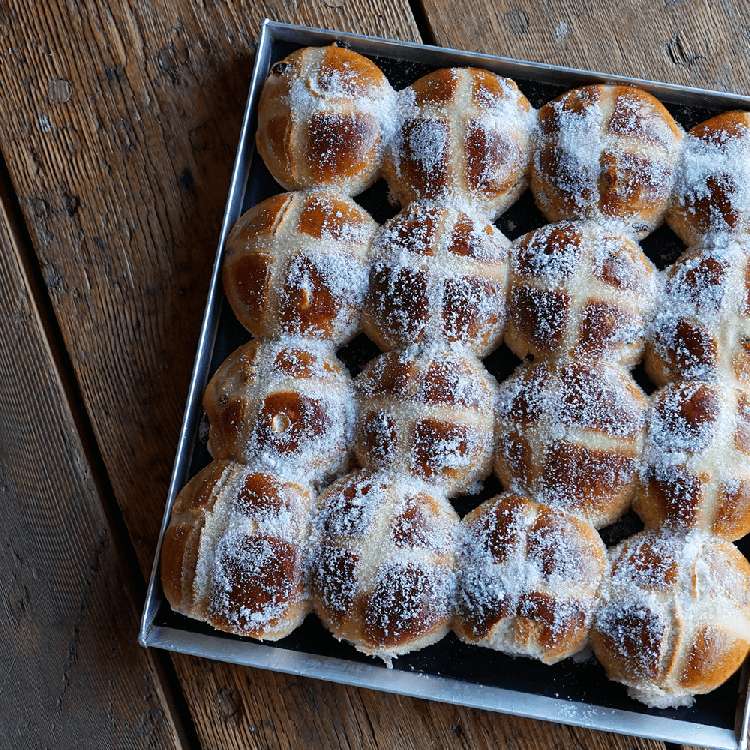How To Make Hot Cross Buns For A Crowd: Scaling Up Recipes

How To Make Hot Cross Buns For A Crowd: Scaling Up Recipes
Scaling Up Recipes
Establish the Original
Establish the Original Recipe:

Before scaling up a recipe, it’s crucial to establish the original recipe’s precise measurements and elements.
Conduct thorough testing and modify seasonings and flavors to ensure the original recipe delivers the desired taste and texture.
Once the unique recipe is perfected, it serves because the baseline for scaling up.
Calculate Proportions
Calculating proportions is a crucial step when scaling up recipes to make sure the desired end result. To scale up a recipe precisely, you need to:
1. Identify the unique recipe’s ingredient weights and measurements.
2. Determine the ratio of the unique recipe to the desired quantity.
For example, if you want to double the recipe, the ratio could be 2:1.
3. Multiply every authentic ingredient weight or measurement by the ratio. For instance, if the unique recipe calls for 2 cups of flour and you want to double it, you would want 4 cups of flour.
Here’s an instance for instance the process:
Original Recipe:
– 2 cups all-purpose flour
– 1 cup milk
– 1 egg
– half of cup sugar
Desired quantity: Triple the original recipe
Ratio: 3:1
Scaled-up recipe:
– 6 cups all-purpose flour (2 cups x 3)
– 3 cups milk (1 cup x 3)
– 3 eggs (1 egg x 3)
– 1 1/2 cups sugar (1/2 cup x 3)
By following these steps, you can precisely scale up recipes to fulfill your required quantity whereas maintaining the recipe’s integrity.
Additional tips for scaling up recipes:
– Pay consideration to the sort of ingredient: Some ingredients could require particular adjustments when scaling up. For occasion, liquids could have to be elevated slightly greater than solids.
– Consider the cooking method: The cooking technique might influence the scaling process. For instance, baking recipes may require more exact measurements than stovetop cooking.
– Use a kitchen scale for accuracy: A kitchen scale offers essentially the most exact measurements, especially for larger quantities.
Adjust Baking Time
When scaling up recipes, it’s essential to regulate the baking time accordingly. This is as a end result of the bigger the batch, the longer it’ll take to prepare dinner by way of.
A good rule of thumb is to extend the baking time by 5-10 minutes for every doubling of the recipe.
So, for example, when you’re doubling a recipe that calls for baking for 20 minutes, you’d bake the doubled recipe for 25-30 minutes.
It’s at all times a good idea to check the buns for doneness earlier than eradicating them from the oven. You can do that by inserting a toothpick into the center of a bun. If the toothpick comes out clear, the buns are carried out.
Baking Instructions
Scaling Up Recipes: Baking Instructions
When scaling up a recipe, it may be very important consider the following components:
1. Ingredients:
– Measure all elements precisely, using the appropriate measuring cups and spoons.
– Adjust the amount of each ingredient proportionally to the dimensions of the batch you’re making.
2. Pan Size:
– Choose a pan that’s giant enough to accommodate the elevated volume of dough.
– If utilizing a smaller pan, you could have to bake the buns in batches.
3. Baking Time:
– The baking time might need to be adjusted slightly relying on the scale of the batch.
– Start by checking the buns a few minutes before the beneficial time to forestall overbaking.
4. Mixing:
– Use a large mixing bowl and utensils to ensure that all elements are thoroughly mixed.
– If using a stand mixer, watch out to not overmix the dough.
5. Kneading:
– Knead the dough till it is smooth and elastic, about 5-7 minutes.
– If the dough is too sticky, add slightly more flour. If it’s too dry, add a little extra water.
6. Rising:
– Allow the dough to rise in a warm place till it has doubled in measurement.
– If the dough is rising too slowly, you can place it in a heat oven with the sunshine on.
7. Shaping:
– Divide the dough into the specified variety of buns.
– Shape the buns right into a round or oblong shape and place them on a baking sheet.
8. Baking:
– Preheat the oven to the temperature specified in the recipe.
– Bake the buns until they’re golden brown and sound hole when tapped.
9. Cooling:
– Allow the buns to chill on a wire rack before serving.
Troubleshooting
Scaling Up Recipes
1. Determine the recipe yield. This is the variety of servings or portions the recipe makes.
2. Calculate the new ingredient amounts. To do that, multiply the unique amount of each ingredient by the scaling issue.
3. Adjust the baking time and temperature. The baking time may need to be increased if the recipe is being doubled or tripled. The temperature may also must be adjusted to stop the buns from burning.
4. Test the recipe. Before baking a large batch of buns, take a look at the recipe on a smaller scale to ensure that the outcomes are passable.
Troubleshooting
- The buns are too dry. This can be triggered by using an excessive amount of flour or not enough liquid. Add more liquid to the dough till it is delicate and pliable.
- The buns are too dense. This can be caused by utilizing too little flour or an extreme amount of liquid. Add extra flour to the dough till it’s agency sufficient to handle.
- The buns are too brown. This may be attributable to baking the buns at too high a temperature or for too lengthy. Reduce the baking temperature or time.
- The buns usually are not cooked by way of. This could be attributable to baking the buns at too low a temperature or for too brief a time. Increase the baking temperature or time.
- The buns have a wierd taste or smell. This could be caused by using old or rancid ingredients. Discard the buns and start over with recent components.
Tips for Success
Scaling Up Recipes
Scaling up recipes is normally a daunting task, but it’s essential to do not forget that it is all about keeping the ratios of ingredients the identical. Here are a couple of suggestions that can help you scale up your recipes successfully:
1. Start with a small batch. This will allow you to get a really feel for the recipe and make sure it actually works earlier than you scale it up to a bigger measurement.
2. Use a kitchen scale. This is the most correct method to measure ingredients, and it’ll assist you to avoid making errors that could throw off your recipe.
3. Pay attention to the order of elements. The order in which you add ingredients can affect the feel and flavor of your dish, so it’s essential to observe the recipe rigorously.
4. Don’t be afraid to experiment. Once you perceive the basics of scaling up recipes, you can begin to experiment with completely different ingredient ratios to create your own distinctive dishes.
5. Here are a couple of further suggestions for scaling up recipes:
- When scaling up a recipe, it is necessary to extend the cooking time accordingly. A good rule of thumb is to add 10 minutes for each doubling of the recipe.
- Be careful not to overcrowd your cooking vessel. This can prevent the meals from cooking evenly and may lead to a watery finished product.
- If you are scaling up a recipe that calls for baking, make sure to regulate the baking temperature accordingly. A good rule of thumb is to scale back the temperature by 25 levels Fahrenheit for each doubling of the recipe.
- Scaling up recipes can be a nice way to avoid wasting money and time. By following the following pointers, you’ll find a way to simply scale up your favorite recipes to feed a crowd.
Storage and Serving
Storing Buns
Storing Buns
- Store buns in an hermetic container at room temperature for up to 2 days, or freeze for as much as 1 month.
Serving
- Serve buns warm, toasted, or at room temperature.
- Top with butter, jam, or your favourite spread.
- Serve with tea, coffee, or Hot Cross Bun Recipe chocolate.
Refreshing Buns
– Store buns in an hermetic container at room temperature for as much as 2 days.
– Freeze buns for up to 2 months. Thaw in a single day at room temperature earlier than serving.
– Refresh buns by warming them in a preheated oven at 350 degrees Fahrenheit for 10-15 minutes.
– Serve buns heat or at room temperature with your favourite toppings.
Serving Suggestions
Store the buns in an airtight container at room temperature for as much as three days.
To freeze the buns, wrap them individually in plastic wrap and place them in a freezer-safe bag or container. Freeze for as much as 2 months.
To reheat the buns, thaw them overnight within the fridge or at room temperature for a quantity of hours. Warm them in a preheated oven at 350 degrees F (175 levels C) for 10-15 minutes, or until heated by way of.
Serve the recent cross buns heat or at room temperature. They can be served plain or with butter, jam, or honey.


Recent Posts
- How Gluten-Free Fried Chicken Differs From Traditional Fried Chicken
- Blueberries And Their Use In Home Remedies
- How Blueberries Are Used In Edible Decorations
- How Blueberries Became A Superfood
- The Cultural Significance Of Blueberries In Indigenous Communities
- The Evolution Of Blueberry Farms Over Decades
- Can Blueberries Improve Your Skin Health
- The Cultural Importance Of Blueberries In Nordic Countries
- The Economic Importance Of Blueberries
- The History Of Blueberries In Native American Diets
- The Role Of Blueberries In Diabetes Management
- The History Of Blueberries And Their Cultivation
- Blueberries In Contemporary Art Installations
- The History Of Blueberry Stains And Their Remedies
- How Blueberries Are Used In Aromatherapy
- The Science Of Blueberry Preservation Techniques